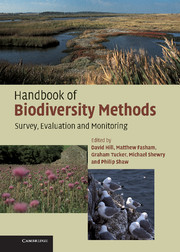Book contents
- Frontmatter
- Contents
- Preface
- Acknowledgements
- Part I Planning
- Part II Habitats
- 4 Introduction to habitat evaluation
- 5 Habitat requirements and issues
- 6 Methods for surveying habitats
- 7 Surveying and monitoring management or environmental impacts
- 8 Habitat conservation evaluation criteria
- Part III Species
- Appendix 1 Monitoring and reporting obligations under international conservation agreements
- Appendix 2 Relationship between BAP Priority Habitat and Broad Habitat categories and Habitats Directive nomenclature
- Appendix 3 Annotated list of key references for plant identification
- Appendix 4 Determining appropriate quadrat size for vegetation sampling
- Appendix 5 The relocation of permanent plots
- Appendix 6 Equipment required for undertaking different types of survey
- Recommended sources of further information
- References
- Glossary
- Index
8 - Habitat conservation evaluation criteria
Published online by Cambridge University Press: 01 September 2010
- Frontmatter
- Contents
- Preface
- Acknowledgements
- Part I Planning
- Part II Habitats
- 4 Introduction to habitat evaluation
- 5 Habitat requirements and issues
- 6 Methods for surveying habitats
- 7 Surveying and monitoring management or environmental impacts
- 8 Habitat conservation evaluation criteria
- Part III Species
- Appendix 1 Monitoring and reporting obligations under international conservation agreements
- Appendix 2 Relationship between BAP Priority Habitat and Broad Habitat categories and Habitats Directive nomenclature
- Appendix 3 Annotated list of key references for plant identification
- Appendix 4 Determining appropriate quadrat size for vegetation sampling
- Appendix 5 The relocation of permanent plots
- Appendix 6 Equipment required for undertaking different types of survey
- Recommended sources of further information
- References
- Glossary
- Index
Summary
KEY EVALUATION CONSIDERATIONS
The conservation importance of habitats occurring in the UK has generally been assessed in terms of the threat status of each habitat type, where attributes such as rarity and rate of decline (of overall area) have been taken into account. In terms of evaluating the conservation importance of any particular habitat type, reference must be made to international and national conservation legislation and initiatives such as the UK Biodiversity Action Plan (UK BAP) process, described further below.
The key considerations with regards to evaluating habitats are listed below.
Check lists of habitats of conservation importance (see below for information on which lists to check and where to obtain the relevant information).
Check existing designation status: for EIAs (see Box 8.1), the search area should extend to 2 km from the boundary of the site. This will inform the results of the Phase 1 survey and highlight areas of habitat on or near the site that are within the boundaries of statutory or non-statutory designations.
Carry out a preliminary (scoping) survey for habitats. This will normally be a Phase I habitat survey (see Section 6.1.5) to identify the broad habitat types present on site.
These three steps should enable the determination of Valuable Ecosystem Components (VECs) (in terms of habitat types) that may potentially be present. To establish the actual presence or absence of a VEC, further survey may be necessary; for habitats, a National Vegetation Classification (NVC) survey (Rodwell, 1991) is recommended.
- Type
- Chapter
- Information
- Handbook of Biodiversity MethodsSurvey, Evaluation and Monitoring, pp. 245 - 250Publisher: Cambridge University PressPrint publication year: 2005



